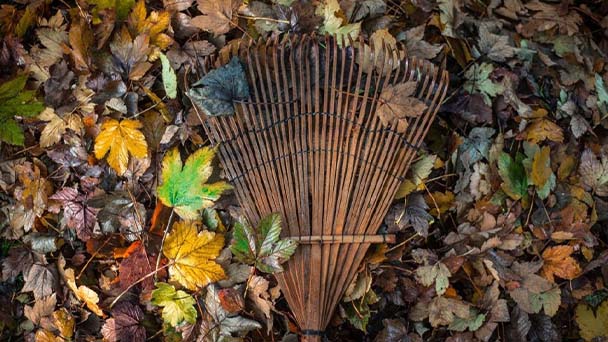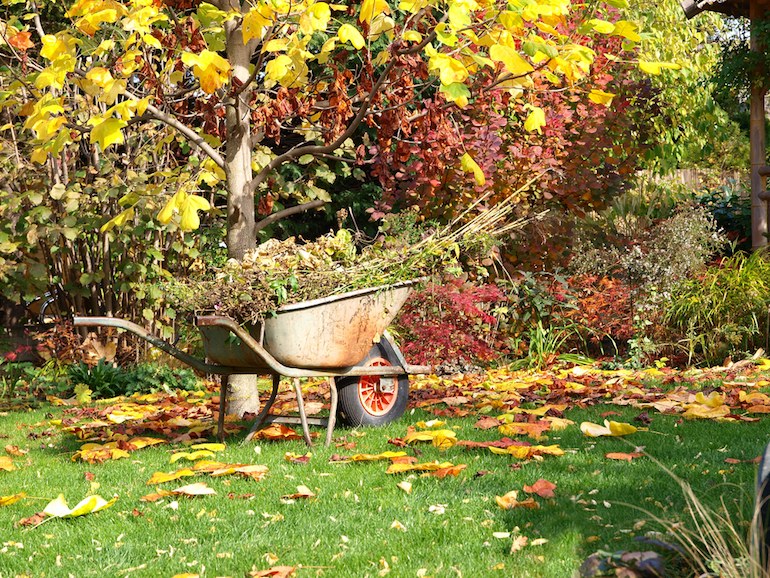How to prepare your garden for winter
Written by Joy
Sep 29 2020

How to prepare your garden for winter? The temperature has dropped, and gardeners should go to their cherished outdoor spaces to prepare for the cold, dark weather. How about your winter garden? But with so much gardening work to do, where is the best place to start?

If you want to fertilize your lawn, you should take the time to thoroughly carry it out. First you can use a rake to flatten or scratch the turf to reduce the accumulation of turf, and then use a gardening fork to circulate the air, which can both improve the flow of air and water in the root structure of the lawn. The last stage is to cover the surface with rotting compost, loam and sand when preparing your garden for winter.
By cleaning and covering the pond in the early fall months, you reduce the work you need to do when spring arrives. Just as importantly, by covering your pond, you also give wild animals a greater chance of survival, because it reduces the chance of freezing completely.
Whether you need to clean up flower beds, lawns, or nasty weeds that emerge from gaps in patios or decks, you should be sure to use old-fashioned hand oil and herbicides. Research the solution you need so that it does not have any negative effects on other plants while preparing your garden for winter.
To prevent them from splitting and occupying your entire garden, you ought to be sure to cut them back to the ground, and collect and dispose of the trimmed plants.
Crops such as buckwheat, vetch, and annual ryegrass increase the organic matter in the garden and improve the soil structure, which means you will have to spend a lot less on fertilizer products.
You can use materials such as wool, straw, ferns, and black pine to withstand the winter weather. These materials are held in place by a metal mesh. Many gardeners also choose to wrap plants with transparent polyethylene film to prevent them from rotting in humid weather.
Although olive trees grow well in cold weather and the drop in temperature actually helps them to produce fruit, they need to be placed in a sheltered place to withstand the cold wind. If they are grown in pots, we usually recommend moving them indoors. Popular Mediterranean plants, such as palm trees, need to cover their roots with mulch to protect them from frost and be completely wrapped. It is necessary to study the plants in your garden to see what their respective needs are to ensure that they can survive the winter.
As the heating is turned on, the air becomes dry and warm. By gathering plants together, their transpiration process means that the air around them will be more humid, preventing them from drying out. You are able to move them into the bathroom for a few days so they can benefit from the humidity of the shower and bath when preparing your garden for winter.
It's time to take the time to prepare your garden now. You can look forward to planting new shrubs and flowers in the spring instead of cleaning up the plants that have not survived the winter. If you work hard enough, you can almost smell the fragrance of flowers in the air!

1. Dig out annual plants
Annual plants, such as poppies, golden needles and sweet peas, are very popular because they bring a vibrant summer color to our garden. Although you might think that digging them out is completely counterproductive, especially when they are such a colorful supplement, they are known to not survive the cold months and may be difficult to maintain. It is more efficient to dig them out and put them in a compost pile when preparing your garden for winter.2. Winter colors
When the golden hues of autumn give way to the 50 gray hues of winter, the garden can become quite dull. In the cold season, there are many flowers that can provide some colors that people need. Plants such as heather, cyclamen, pansy and snowdrops can be planted in pots or hung in baskets to add color in your winter garden.3. Lawn fertilization
Hot and dry weather, paddling pools and grass games throughout the summer will make our grass need some serious thin layer protection. By fertilizing your lawn, you provide it with nutrients, which will restore its health and promote its growth, which means that by next summer, you will have a beautiful lawn to enjoy.If you want to fertilize your lawn, you should take the time to thoroughly carry it out. First you can use a rake to flatten or scratch the turf to reduce the accumulation of turf, and then use a gardening fork to circulate the air, which can both improve the flow of air and water in the root structure of the lawn. The last stage is to cover the surface with rotting compost, loam and sand when preparing your garden for winter.
4. Cover your pond
To be honest, this is a time-saving exercise. In the winter months, rain, snow, strong winds and strong winds will have a great impact, causing garden ponds and water features to be filled with garden objects, causing blockages and unpleasant sights in the process of decay.By cleaning and covering the pond in the early fall months, you reduce the work you need to do when spring arrives. Just as importantly, by covering your pond, you also give wild animals a greater chance of survival, because it reduces the chance of freezing completely.
5. Weeding
Weeds are the ultimate enemy of gardeners. Now devote your time to the weeding of the garden. When the weather gets warm again, you won't have another difficult task.Whether you need to clean up flower beds, lawns, or nasty weeds that emerge from gaps in patios or decks, you should be sure to use old-fashioned hand oil and herbicides. Research the solution you need so that it does not have any negative effects on other plants while preparing your garden for winter.
6. Prune perennials
Worthy of praise are perennials, because we know that we can rely on them to accompany us through all the seasons. However, with such a tenacious force, it can also be seen that they spread rapidly like wildfire and completely occupy the garden.To prevent them from splitting and occupying your entire garden, you ought to be sure to cut them back to the ground, and collect and dispose of the trimmed plants.
7. Cover crops
In winter, using cover crops is a good way to prevent soil erosion because they can also help you avoid the negative effects of temperature drops on soil quality and soil fertility.Crops such as buckwheat, vetch, and annual ryegrass increase the organic matter in the garden and improve the soil structure, which means you will have to spend a lot less on fertilizer products.
8. Protect small trees
Plants need your protection and care as they grow and mature-just like children. This sounds especially true throughout the winter when the weather becomes cold and cold.You can use materials such as wool, straw, ferns, and black pine to withstand the winter weather. These materials are held in place by a metal mesh. Many gardeners also choose to wrap plants with transparent polyethylene film to prevent them from rotting in humid weather.
Although olive trees grow well in cold weather and the drop in temperature actually helps them to produce fruit, they need to be placed in a sheltered place to withstand the cold wind. If they are grown in pots, we usually recommend moving them indoors. Popular Mediterranean plants, such as palm trees, need to cover their roots with mulch to protect them from frost and be completely wrapped. It is necessary to study the plants in your garden to see what their respective needs are to ensure that they can survive the winter.
9. Compost
By placing a few inches of compost and then covering it with a layer of mulch, you can protect your plants from hard frost, and also protect any wild animals that like to eat them and provide them with important nutrients. You'd better not forget to protect your indoor plants. Although your indoor plants will be protected from the cold weather that winter brings, they still need some adjustments to adapt to their daily lives. During the winter months, plants grow slowly or enter a dormant period, they require less water and hardly need any fertilizer.As the heating is turned on, the air becomes dry and warm. By gathering plants together, their transpiration process means that the air around them will be more humid, preventing them from drying out. You are able to move them into the bathroom for a few days so they can benefit from the humidity of the shower and bath when preparing your garden for winter.
It's time to take the time to prepare your garden now. You can look forward to planting new shrubs and flowers in the spring instead of cleaning up the plants that have not survived the winter. If you work hard enough, you can almost smell the fragrance of flowers in the air!
Latest Updated
- Benefits of Bugleweed - 7 Science-backed Health Benefits
- Bugleweed Dangers & Side Effects - Is It Poisonous?
- How to Plant Evergreen Trees - What You Should Know
- When to Plant Evergreens - Grow Guide for Evergreen Trees
- 12 Wonderful Evergreen Shrubs for Your Garden
- 12 Popular Evergreen Plants with Pictures for Beginners
- When And How To Prune A Lilac Bush Like a Pro
- How to Grow & Care for Lilac Vine (Hardenbergia Violacea)
- Japanese Lilac Tree (Syringa Reticulata) Care & Propagation Guide
- Shumard Oak Pros and Cons - What to Know
Popular Articles
- Winter maintenance of Antirrhinum Majus
- How to Grow Terminalia Mantaly Tree
- How to Grow and Care for Crossostephium Chinense
- How to grow Antirrhinum Majus in spring
- Peristeria Elata (Dove Orchid) Profile: Info & Care Guide
- Underwatered Snake Plant (Sansevieria Trifasciata) - Signs And How To Fix
- How to Care for Brazilian Jasmine Plant (Mandevilla Sanderi)
- How to Grow & Care for Graptopetalum Purple Delight in Summer
- Rosa Chinensis (China Rose): Plant Growing & Care Tips
- How to Care for Baby Sun Rose (Aptenia Cordifolia)